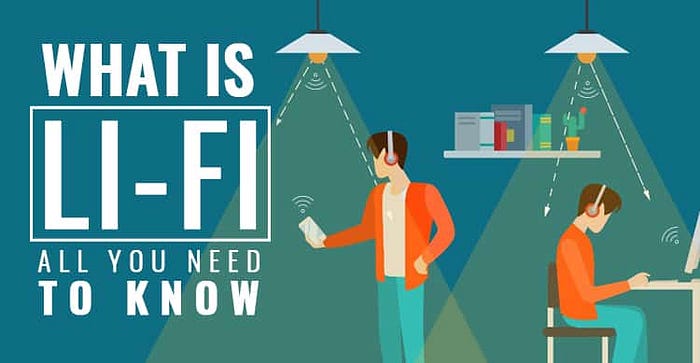
Inan increasingly connected world, the need for fast, reliable, and secure wireless communication is more critical than ever. However, with the rise in wireless dependency comes the increased risk of signal interference and intentional disruption — commonly known as jamming. While traditional radio frequency (RF)-based technologies such as Wi-Fi, LTE, and Bluetooth remain vulnerable to various jamming techniques, LiFi (Light Fidelity) emerges as a robust and secure alternative, inherently resilient to these threats.
This article explores in detail why LiFi continues to function reliably even in environments saturated with RF jamming and how this capability positions it as a key enabler in secure communications.
1. Understanding LiFi: A Quick Technical Overview
LiFi is a form of optical wireless communication (OWC) that uses modulated light — typically from LEDs — to transmit data to a photodetector. Data rates in LiFi systems can exceed 10 Gbps under laboratory conditions and up to several hundred Mbps in commercial implementations.
How It Works:
- Modulation: Data is encoded by rapidly varying the intensity of light (on-off keying, OFDM, or other schemes).
- Transmission Medium: Visible or near-infrared light (380 nm to 780 nm range for visible; up to 1550 nm for IR).
- Reception: A photodiode detects modulated light and converts it to an electrical signal.
- Duplexing: Full-duplex communication is achieved through separate uplink channels (often using infrared or VLC modulated with low-power emitters).
2. The Nature of RF Jamming and Its Limitations
RF Jamming Defined
RF jamming is a deliberate attempt to disrupt wireless communication by overpowering legitimate signals using electromagnetic noise or malicious signals.
Common RF Jamming Techniques:
- Constant Jammer: Transmits continuous interference across a frequency band.
- Deceptive Jammer: Mimics legitimate transmissions to confuse receivers.
- Reactive Jammer: Transmits only when it detects a legitimate signal.
- Random Jammer: Alternates between jamming and sleeping to avoid detection.
These techniques exploit the shared and open nature of RF spectrum, especially in unlicensed bands like 2.4 GHz and 5 GHz (Wi-Fi).
3. Why LiFi Is Immune to Typical RF Jamming
a. Spectrum Isolation
LiFi operates entirely outside the electromagnetic spectrum used by RF systems. Since RF jammers emit radio waves, they have no physical effect on optical signals. Jammers designed for RF cannot interfere with the photons used in LiFi.
Key Fact: LiFi uses light — electromagnetic waves with frequencies from 430 THz to 770 THz, orders of magnitude above RF (typically kHz to GHz range).
b. Directionality and Containment
Unlike omnidirectional RF signals, LiFi requires a line-of-sight (LoS) or reflective path between transmitter and receiver. This spatial constraint:
- Prevents external jammers (outside the room or out of view) from injecting interference.
- Provides natural physical-layer security, as eavesdropping or disrupting the signal requires physical access to the beam path.
c. Immunity to Electromagnetic Interference (EMI)
Industrial environments with motors, transformers, or welding equipment generate significant EMI that affects RF performance. LiFi is immune to EMI, as it uses optical (not electrical) propagation through the air.
d. High Spatial Reuse and Cell Isolation
LiFi enables ultra-dense networks through localized coverage areas called “attocells”. Each LED acts as a data access point. These cells:
- Do not interfere with adjacent cells due to limited light spread.
- Cannot be simultaneously jammed unless the jammer is physically present in each cell.
4. Practical Implications of Jamming Resistance
a. Military and Tactical Use
In conflict zones or secure facilities, RF jamming is a standard tool to disrupt enemy communication. LiFi provides a jam-resistant, localized, and secure channel, ideal for:
- Tactical command centers
- Undercover operations
- Secure communications in submarines, bunkers, or UAVs
b. Aviation and Aerospace
RF emissions in aircraft can interfere with avionics. LiFi offers an EMI-free alternative for:
- In-flight entertainment systems
- Cabin control networks
- Aircraft-to-aircraft ground communication (in low-light scenarios)
c. Hospitals and Medical Devices
Many hospitals restrict RF usage due to interference with sensitive medical equipment. LiFi can deliver high-speed, non-interfering data for patient monitoring, imaging, and hospital intranet access.
d. Industrial IoT and Factories
In factories with high EMI, traditional wireless systems can be unreliable. LiFi provides a high-reliability alternative for:
- Real-time machine communication
- Sensor networks in EMI-heavy zones
- Wireless control in nuclear or high-voltage facilities
5. Limitations and Challenges
While LiFi’s immunity to jamming is a major advantage, it is not without challenges:
- Line-of-sight Dependency: Blockage of the light path can disrupt communication.
- Limited Range: LEDs cover relatively small areas compared to Wi-Fi.
- Ambient Light Interference: Sunlight and strong ambient sources can introduce noise, although filters and advanced modulation help mitigate this.
- Uplink Design: Requiring an infrared or other light-based uplink adds complexity.
Despite these, hybrid networks combining LiFi and Wi-Fi (e.g., in LiFi-ready routers) are emerging to balance strengths.
6. The Future: Toward Secure, Jam-Proof Wireless Ecosystems
As threats to RF communications increase — through intentional jamming, espionage, or congestion — LiFi’s spectrum isolation, security, and immunity make it a strong candidate for critical systems. Research is also underway on integrated LiFi-RF architectures, machine learning-based adaptive modulation, and terabit optical networks.
Ultimately, the very nature of LiFi — a communication method based on light — gives it a strategic edge in a world dominated by invisible, vulnerable RF signals. In a jammed, congested, and adversarial electromagnetic environment, LiFi not only survives — it thrives.
Conclusion
LiFi is more than just a faster version of Wi-Fi. Its unique physical properties give it an unmatched resistance to jamming, interference, and unauthorized interception. As we continue to push the limits of secure and reliable wireless communication, LiFi is set to play a pivotal role in shaping the next generation of networks — especially in environments where typical jamming would otherwise bring everything to a halt.
